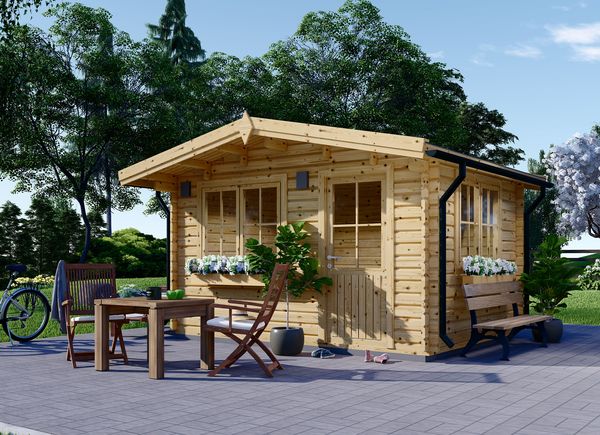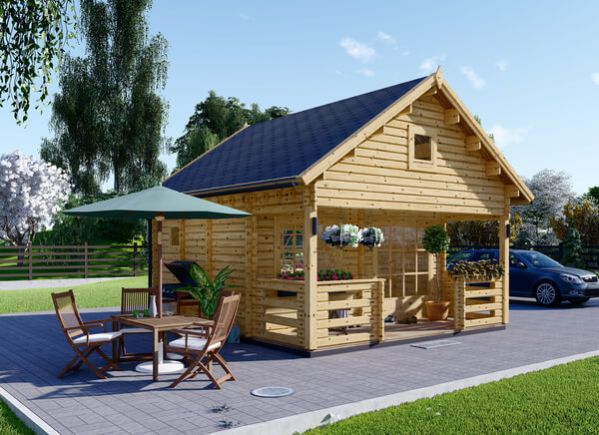
If you’ve ever felt like your garden could use an upgrade, you could go for something that’s being chosen by more and more British households – a log cabin. The process is so exciting, starting from picking the model you like most, and ending with customisation and installation. Actually, talking about building a log cabin – you can simply do it yourself! We encourage our customers to build a log cabin themselves, since prefabricated constructions have this added benefit. If you’re looking to cut costs and broaden your skillset, check out these self-build log cabins in the UK!

Residential log cabin LINDA – customer’s picture
Why Should You Build a Log Cabin?
If you have the space for it, why not enhance your everyday life and raise the worth of your land at the same time? The cool bit is that the selection is far and wide, with many different styles, layouts, sizes, and customisation options to choose from. Quick-garden.co.uk’s buildings are sustainable, timeless, and time-tested. Building a log cabin that’s what you hoped for should be an inspiring process.
Another consideration is the versatility of them. Our models have either spacious rooms or feature open-plan concepts, which makes furbishing and refurbishing them later a walk in the park. If that’s not reason enough, think about anything you’d like to do at home, but lack space for. If you build a log cabin, you can finally have a dedicated room or two for your art, fitness, and more. Invest in yourself!

Garden Log Cabin PAULA – customer’s picture
Essential Planning Before Building a Log Cabin
Our experts are here to assist you throughout the process, but it’s also sensible to come forward with some preparations. Here’s what we recommend to do or look over:
𑇐 Decide on the location of the new building. A lot of log cabins for the garden are placed close to the main residence for easy access. You can use your vicinity map to view the available outdoor spaces within your property. Make sure that you know and comply with the regulations regarding additional constructions in your area.
𑇐 Have a look at our log cabins and decide what features and styles you prefer, e.g., what’s essential and what can be added later, whether you’d like a standard or bespoke structure, and so forth. Building a log cabin is fun when it’s the right model!
𑇐 Draw up your budget. This will help you narrow down your search for the best self-build log cabin that’s still reasonably priced.

Garden log cabin AGNES – customer’s picture
Get inspired for your self-build log cabin
Whether you’re looking for a residential building or more of an annexe, checking out a few possible models could more than spark your imagination. We’ll start with some of our bestsellers, and then go a few sizes down to give you a good idea of what the range is.
Firstly, let’s look at the building regulation-friendly model AMELIA. Sporting a large covered terrace, a pronounced double-pitched roof, and a well-planned layout, this structure could make you want to start building a log cabin sooner rather than later. Another enticing option is the two-storey ALBI. This model is also a classic, with an inviting, cosy promise. If you have limited space, it would make sense to choose a structure with the possibility of creating relaxation zones upstairs.
Looking more toward something with a few size options, DREUX and ORLANDO are both tempting model lines. These structures could serve either as hobby rooms or storages that still bring a distinct sense of style to your garden. Besides, since they’re more compact than the previous models, they would make the task of building a log cabin a lot easier and more efficient.
A Step-by-Step Guide to Building Your Log Cabin
DIY can be a remarkably promising and lucrative project. Just imagine seeing your new log cabin kit in the UK come to life bit by bit, and then enjoying the rewards at its completion!
Step 1: Choose Proper Foundation
Since you can choose between concrete base, concrete slab, and timber frame foundation for our self-build log cabins in the UK, it’s important to familiarise yourself with their uses, price points, and main features. Fortunately, we’ve provided some information about it on this Foundation page. Besides, you can always reach our experts via email: clients@quick-garden.co.uk!
Step 2: Use the hardware to fasten the floor beams
Follow the assembly instructions to screw in the foundation beams. Please note that the floorboards are only fastened after the walls are completed. Following the instructions is crucial, since the foundation is what creates the structural integrity of the building.
Step 3: Move on to the wall and the windows
As per the instructions, complete the walls, then put in the floorboards and the windows. As you’ll notice during the wall mounting process, the boards interlock in the corners, adding stability to the building. Make sure you’re also in a stable position at all times to prevent any accidents.
Step 4: Add the roof and the accessories
The roof is finally ready to be installed. Once you finish the assembly, you can also add the primer or paint the slow-grown conifer timber if you added these accessories to your order.

Log cabin SOPHIA under construction
The Common Challenges of Building a Log Cabin and a Simple Solution
While the assembly process may go smoothly for some, it’s not uncommon to face a few struggles. What may happen is that building a log cabin could take longer than you accounted for. This is especially true for more intricate structures, such as ones with a layer of cladding and insulation. Larger models may pose more challenges as well. If you have little to no experience with these types of DIY projects, that could also become a factor. Finally, if the weather’s dreadful, say, it starts raining for days at a time, that could also postpone the finish line of the self-build log cabin kit assembly. However, if you’d like to avoid any possible hiccups, we recommend adding the assembly service to your order. Quick and efficient, they’ll build your favourite model with ease!
Now that you’ve seen some of our selections, what are your ideas? Are you excited to build your own log cabin? If so, do get in touch with our friendly team at 02070994301, and we’ll get started right away!















